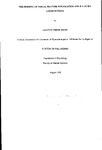THE PRIMING OF VISUAL FEATURE INTEGRATION AND ILLUSORY CONJUNCTIONS
| dc.contributor.author | SMITH, GRAHAM DEREK | |
| dc.contributor.other | School of Psychology | en_US |
| dc.date.accessioned | 2013-09-17T09:45:01Z | |
| dc.date.available | 2013-09-17T09:45:01Z | |
| dc.date.issued | 1998 | |
| dc.identifier | NOT AVAILABLE | en_US |
| dc.identifier.uri | http://hdl.handle.net/10026.1/1777 | |
| dc.description.abstract |
Whether non-spatial previewing can interact with the process of integrating visual features and thereby affect the formation of illusory conjunctions was studied. A series of ten experiments were undertaken that employed methods borrowed from the illusory conjunction and visual previewing paradigms. Participants reported the identities of two briefly presented target objects. Preview stimuli were presented prior to the to-be-reported target stimuli. The preview objects and target objects were colour-filled geometric shapes. The effects of two types of non-spatial previewing were investigated; feature previewing and conjunction previewing. In feature previewing the preview stimuli were congruent or incongruent with one of the target stimuli on a single stimulus dimension. The results suggest that feature previewing does not affect the production of illusory conjunctions. In conjunction previewing the preview display contains an object composed of two features that also appear in the subsequent target display. A congruent conjunction preview display contains an object that is identical to one of the target objects. An incongruent conjunction preview display contains an object composed of a colour and a shape that appear in different target objects. The results suggest that incongruent conjunction previews cause more illusory conjunctions than congruent conjunction previews do. Conjunction previews appear to priming of the process of visual feature integration. Alternative explanations of the results were ruled out by subsequent experiments. The finding of the conjunction preview effect has implications for the current theories of visual feature integration and illusory conjunctions; e.g., feature integration theory (Treisman 1990; Treisman & Gelade) and location uncertainty theory (Ashby, Prinzmetal, Ivry & Maddox, 1996; Prinzmetal &. Keysar, 1989). | en_US |
| dc.language.iso | en | en_US |
| dc.publisher | University of Plymouth | en_US |
| dc.title | THE PRIMING OF VISUAL FEATURE INTEGRATION AND ILLUSORY CONJUNCTIONS | en_US |
| dc.type | Thesis | |
| plymouth.version | Full version | en_US |
| dc.identifier.doi | http://dx.doi.org/10.24382/4204 | |
| dc.identifier.doi | http://dx.doi.org/10.24382/4204 |
Files in this item
This item appears in the following Collection(s)
-
01 Research Theses Main Collection
Research Theses Main


